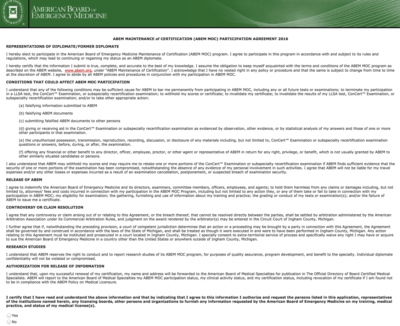at least temporarily.
From AAEM:
Dear AAEM Members,
On May 17, 2007, AAEM, along with leaders from ACEP and ENA, met face-to-face with The Joint Commission (TJC) to relay our concerns with Interim Standard MM 4.10. I am happy to report that this has resulted in a positive and rapid change in The Joint Commission’s position. The latest ruling and interpretive guidelines can be found athttp://www.jointcommission.org/AccreditationPrograms/Hospitals/urgent.htm.
Essentially, a medication ordered by an emergency physician can be administered by an emergency nurse (or respiratory therapist) without pre-approval by a pharmacist as long as the emergency physician is immediately available to intervene should the patient experience an adverse reaction.
Tom Scaletta, MD FAAEM
President, AAEM
Before this the rule wanted every medication checked by a pharmacist before it was administered, a stunning display of ignorance regarding how medicine is practiced and the realities of the numbers of pharmacists available to even do the job. To do the job were it a good idea, which it isn’t.
The link has the following:
The Joint Commission will now permit organizations to implement the two exceptions in Standard MM 4.10, EP 1 more broadly in order to minimize treatment delays and patient back-up. To clarify this position, each exception is addressed below emphasizing its implementation in the ED:
- Exception 1: “…unless a licensed independent practitioner controls the ordering, preparation, and administration of the medication.”
Implementation: When using this exception, medications ordered by a licensed independent practitioner in the ED can be processed, including administration of the medication, by a registered nurse or other licensed staff with medication administration responsibilities (e.g. respiratory therapist) in accordance with law and regulation. A licensed independent practitioner will not be required to remain at the bedside when the
medication is administered. However, the licensed independent practitioner must remain available to provide immediate intervention should a patient experience an adverse medication event.- Exception 2: “…in urgent situations when the resulting delay would harm the patient, including situations in which the patient experiences a sudden change in clinical status.”
Implementation: When using this exception, urgent care situations will be defined by the licensed independent practitioner who is providing care to the patient.
Which is how it has been, and should always have been.




Makes sense to me. All the red tape worries me more and more. Let doctors and nurses do what they do best: care for the patient in an efficient and rapid fashion.
OK – I must be missing something here – what about critical access hospitals without an ED attending on site? Or where the ED doc is on call?
And how does that standard impact pre-hospital care by medics working from algorithms? Are they mandating changes in how ED docs interface with field medics around medication administration?
This seems to be such a pot-holed road to go down…. I wonder if the JCAHO folks would just hold off and instead let the IHI take the initiative to develop standards around ED safe medication administration – that would much more pragmatic and palatable.